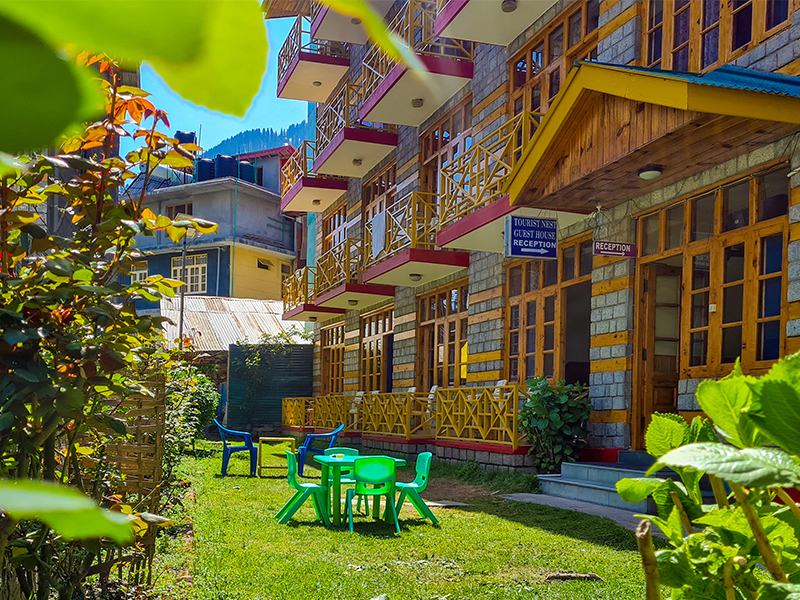

Hadimba Devi Temple, located in Manali, Himachal Pradesh, India, is dedicated to Hadimba Devi, a character in the Indian epic Mahabharata. The temple is renowned for its unique architecture and serene surroundings. Here's a brief history:
Legend: The temple is named after Hadimba, the wife of Bhima, one of the Pandava brothers from the Mahabharata. According to legend, Hadimba performed severe penance to attain the status of a goddess. She is revered as a powerful deity in this region.
Construction: The temple is believed to have been built in the 16th century, around 1553, by Raja Bahadur Singh, the ruler of the Kullu Valley. The temple's ...



.jpg)



.webp)





.webp)


Packages Of Manali
Enjoy mountains, adventure and cosy stays in the heart of Himachal.

Places To Visit In Manali
Top places to visit in Manali, perfectly explored.
.webp)
Blogs Of Manali
Where Himalayan adventure meets tranquil valleys
.webp)
Images Of Manali
Explore the magic of Manali through breathtaking images
Packages Of Manali
Places To Visit In Manali
Blogs Of Manali
Images Of Manali
The Hadimba Devi Temple, also known as the Hadimba Temple, is a significant cultural and historical landmark in Manali, Himachal Pradesh. Here are some top things to know about the temple:
Historical Significance: The temple is dedicated to Hadimba Devi, a character from the Indian epic Mahabharata. Hadimba was the wife of Bhima, one of the Pandava brothers, and the mother of Ghatotkacha.
Unique Architecture: Built in 1553 by Maharaja Bahadur Singh, the temple is renowned for its distinctive architectural style. It features a pagoda-like structure with a three-tiered roof covered in wooden tiles and intricately carved wooden doorways and walls.
Sacred Location: The temple is situated amidst a dense cedar forest called Dhungiri Van Vihar, adding to its serene and spiritual ambiance. The forest surroundings make it a tranquil spot for visitors.
Cultural Importance: The temple is an important religious site for the local people and attracts devotees from across the region. The annual Hadimba Devi Festival, held in May, is a major event that draws large crowds.
Natural Beauty: The temple's location in the lush green forests of the Kullu Valley provides a picturesque setting, making it a popular spot for photography and nature walks.
Stone Idol: Inside the temple, a 60 cm tall stone idol of Hadimba Devi is worshipped. The interior is simple yet spiritually significant, reflecting the temple's ancient heritage.
Mythological Connection: According to legend, Hadimba meditated in the area and was eventually sanctified as a goddess. The temple is believed to be the place where she performed her penance.
Accessibility: The Hadimba Devi Temple is easily accessible from Manali town, located about 2 km from the main market. Visitors can reach it by walking or taking a short drive.
The Hadimba Devi Temple, with its rich history, unique architecture, and serene surroundings, is a must-visit attraction for those traveling to Manali, offering a blend of cultural heritage and natural beauty.
Best Time To Visit Hidimba Devi Temple Is From March To June And September To December
Hadimba Devi Temple, located in Manali, Himachal Pradesh, India, is dedicated to Hadimba Devi, a character in the Indian epic Mahabharata. The temple is renowned for its unique architecture and serene surroundings. Here's a brief history:
Legend: The temple is named after Hadimba, the wife of Bhima, one of the Pandava brothers from the Mahabharata. According to legend, Hadimba performed severe penance to attain the status of a goddess. She is revered as a powerful deity in this region.
Construction: The temple is believed to have been built in the 16th century, around 1553, by Raja Bahadur Singh, the ruler of the Kullu Valley. The temple's architecture is distinct, with a pagoda-style structure made of wood and stone. It stands out for its intricately carved wooden doors and walls.
Architecture: The temple's unique architectural style reflects a blend of local Himachali and Buddhist influences. The wooden structure is built around a huge rock, which is worshipped as the deity's image. The temple's design also incorporates intricate wood carvings, depicting mythological themes and symbols.
Significance: The temple is a popular pilgrimage site and a symbol of cultural heritage. It attracts devotees and tourists from all over the world. The temple is particularly crowded during the annual Hadimba Devi fair, held in May, which features folk music, dance, and other cultural performances.
Conservation Efforts: Over the years, efforts have been made to preserve the temple's unique architecture and cultural significance. The temple is under the protection of the Archaeological Survey of India (ASI) and is a protected monument.
The Hadimba Devi Temple stands as a testament to the rich cultural and religious heritage of the region, attracting visitors with its historical significance, architectural beauty, and serene surroundings.
Here are some interesting facts about the Hadimba Devi Temple:
Unique Architecture: The temple is famous for its unique architecture, with its roof covered in timber tiles and a cone-shaped top. It is built over a large rock that is worshipped as a representation of Hadimba Devi.
Absence of Idol: Unlike most Hindu temples, Hadimba Devi Temple does not house an idol of the deity. Instead, a footprint on a stone inside the temple is worshipped as the representation of Hadimba Devi.
Ancient Heritage: The temple is believed to be around 500 years old, dating back to the 16th century. It has been a site of worship for centuries and is deeply rooted in local folklore and tradition.
Connection to Mahabharata: Hadimba Devi is a character from the Indian epic Mahabharata. She was the wife of Bhima, one of the Pandava brothers. The temple is dedicated to her and is said to be built at the spot where she performed meditation.
Festival Celebration: The temple is a focal point for celebrations, especially during the annual festival of Dhungri Mela, which is held in honor of Hadimba Devi. The festival features folk music, dance, and local cultural performances.
Natural Surroundings: The temple is set amidst a beautiful cedar forest, adding to its serene and picturesque surroundings. It is a popular tourist destination in Manali, offering a tranquil retreat from the bustling town.
Protected Monument: The Hadimba Devi Temple is a protected monument under the Archaeological Survey of India (ASI) due to its historical and architectural significance. Efforts are made to preserve its unique wooden architecture and cultural heritage.
These facts highlight the historical, cultural, and architectural importance of the Hadimba Devi Temple, making it a significant landmark in the region.

The Hadimba Devi Temple is not only a place of worship but also steeped in rich folklore and stories. Here are some popular stories associated with the temple:
The Legend of Hadimba Devi: The temple is named after Hadimba, the wife of Bhima and a character from the Mahabharata. According to legend, Hadimba was a powerful demoness who fell in love with Bhima and married him. After the Kurukshetra war, Hadimba accompanied the Pandavas to their kingdom but eventually decided to retreat to the forest to meditate. It is believed that she turned into a rock to concentrate better, and the temple was built around this rock.
The Demoness Turned Deity: Hadimba, originally a demoness, is worshipped as a goddess in the temple. It is said that after her death, she attained the status of a goddess due to her devotion and penance. The temple is a symbol of her transformation from a demoness to a revered deity.
The Protection of the Temple: Another legend associated with the temple is about its protection by the gods. It is said that the temple was once attacked by a demon who tried to destroy it. However, the gods intervened, and the demon was defeated. Since then, it is believed that the temple is under the protection of the gods, ensuring its safety and sanctity.
The Annual Festival: The temple is known for its annual festival, Dhungri Mela, which is held in May. The festival is a celebration of Hadimba Devi and features colorful processions, music, dance, and local cultural performances. It is a time when the local community comes together to honor the goddess and seek her blessings.
The Spiritual Significance: The temple is not only a place of worship but also holds spiritual significance for many. It is believed that the goddess has the power to fulfill the wishes of her devotees, and many people visit the temple to seek her blessings for health, prosperity, and happiness.
These stories and legends add to the mystique and allure of the Hadimba Devi Temple, making it a place of historical, cultural, and spiritual importance.
The Himalayan Mountains are a majestic mountain range in South Asia, spanning five countries. They boast the world's highest peaks, including Mount Everest. These young, growing mountains feature rugged, snow-capped peaks, deep valleys, and glaciers. The Himalayas influence regional climate, harbor unique biodiversity, and hold cultural and spiritual significance. They attract adventurers, nature lovers, and spiritual seekers from around the world.